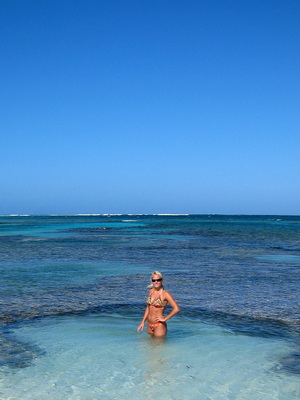
A semi circular stretch of a coral ledge frames a lovely little swimming hole. The tide was out so you could see all the coral outcroppings as we wandered along the beach towards the North West Point.
Marta

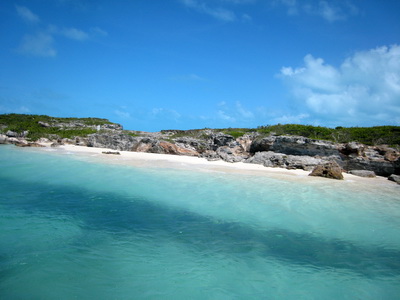
We motored out from our Marina channel to a small sliver of white powdery sand beach for a few hours Sunday afternoon
It was pretty windy and the ocean was rough last Sunday but we thought it would be fine. It was a bumpy ride over the white caps so much so that I was literally gripping onto the hand rail. Luckily we were protected from the wind and things calmed down as we approached and moored at a little beach.
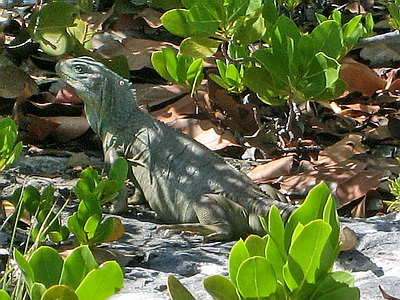
I was thrilled to see several Rock Iguanas and I could hear the rustling of many others as they made their escapes before I could spot them.
The Turks and Caicos Rock Iguana was re-introduced to several of the many little Cays. It is an endangered species of lizard and is endemic to the Turks and Caicos Islands.
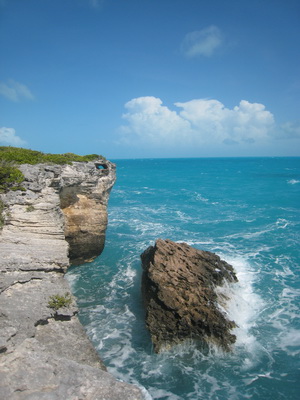
The waves were pounding on the far side of the island and I was fascinated by the large rock formation with a hole in it.
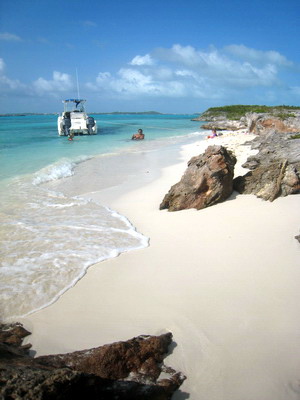
We enjoyed the sun, sand and beach and of course we had it all to ourselves. Even the iguanas didn't mind sharing this little spot of paradise.
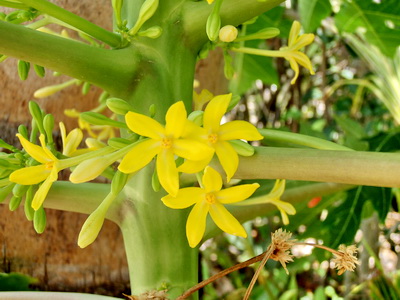
Papaya trees come in one of three sexual forms: male, female and hermaphrodite and the photo above is of a male flowering papaya.
The Papaya tree or Paw Paw is found growing wild throughout the Turks and Caicos Islands and we have several here at Harbour Club. Presently, Barry and I are juicing these wild papayas almost every day as we have so many that are ready to eat right now.
Male Papaya flowers have no ovaries and therefore do not produce any fruit. Female flowers have an ovary and are borne on the stem of the plant where the leaf is attached.
Some papaya bear only short stalked female flowers while others bear male clusters of flowers and pollination is done by the wind.
The ovary of a female Papaya plant must receive pollen from either a male or hermaphrodite plant before it can be fertilized and produce a fruit bearing viable seeds. Insects and or the wind will carry the pollen.
Papaya trees can grow from 6 to 20 feet tall and have a head of foliage much like a palm tree up at the top. The trunk is soft wooded, never developes a bark and is ringed with scars from previous leaf stems that have dropped off.
Wild papaya fruits aren’t really that large but they are favoured by the birds so long as Barry doesn’t get to them first. They are delicious served up as a smoothie or eaten with lots of fresh lime juice.
Papain from the papaya is used by the locals and applied topically for the treatment of cuts, rashes, stings and burns. It is said that Christopher Columbus named the papaya or paw–paw, ‘the fruit of the angels’. Try some papaya with fresh lime juice for a tasty treat…….it is ripe and soft and has a sweet and delightfully vibrant orange flesh much like the consistency of a peach.
Marta
I came out onto our deck today at Harbour Club to find some Anole Lizards sizing each other up as they prepared to defend their territory. I have never seen them quite this aggressive towards one another but I know that they are very territorial.
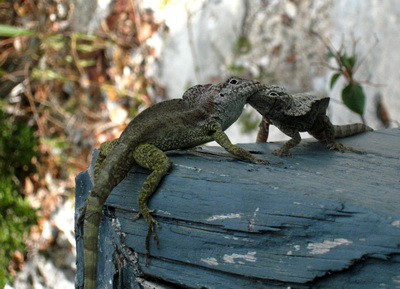
One Anole had a strong hold on the other so much so that his head was almost torqued right around. The fight consisted of grabbing the opponent with the mouth and then using the legs and tail for leverage.
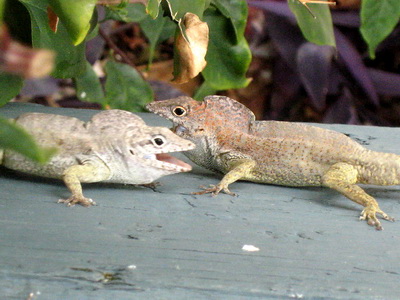
A number of times these two disengaged and I expected one of them to turn tail. They seemed intent on settling the territorial dispute.
We find so many Anoles and Curly Tailed lizards on the grounds of Harbour Club Villas and Marina. Some are now getting quite big especially the Curly Tailed lizards. Hope you enjoyed these photos and I will look for some good ones of the Curly Tails for another post.
Marta
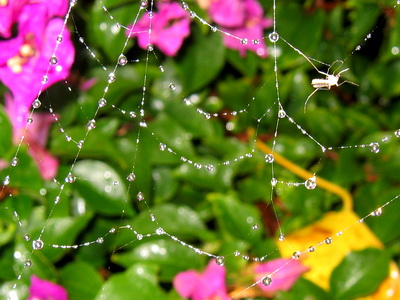
Liquid sunshine pearl drops on a spider's web taken one afternoon that I found irresistable for a photo.
I’m not a big fan of spiders at any time but when I came across a spider’s web dotted with drops of rain after one of our brief rain showers, I couldn’t resist trying to get some photos.
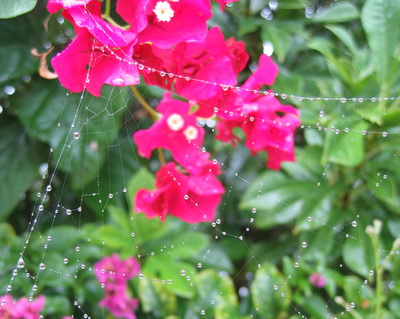
The spider's web with strands of liquid pearls stood out from the backdrop of one of my fushia coloured bouganvillea.
The gardens here at Harbour Club Villas always present something interesting or new for me to photograph. Yesterday for example, I couldn’t get a photo of a baby dove that was trying to fly. It was in our wild area hidden somewhat by the bush. Never mind……..there’s always shots that are missed but something else always comes along to take its place.
Marta
The water was so clear yesterday with sun reflections dancing and creating silvery patterns as we just played in the water. Malaika just loved being buoyant in the foot deep waters of the south side of Provo. She’s beginning to kick her legs and is totally unafraid of the water.
We took a little break and close to the shore where we were sitting in the water, we were joined by some tiny little fish. Malaika was delighted but stayed close to Mom.
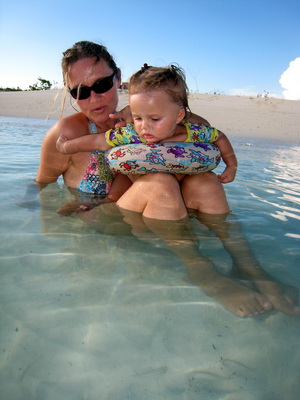
Malaika spots little fish from the safety of Mom's lap. You can just make the fish out at the bottom of the photo below Mom's feet.
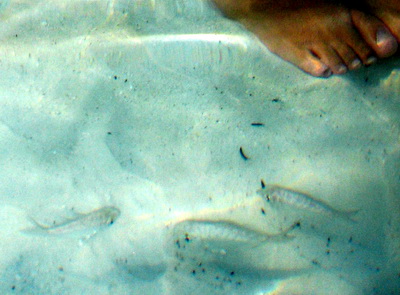
Here's a blow up of the little fish that were swimming around us as we sat in a few inches of water at the beach
An idyllic afternoon spent just lounging in the water close by our villas at Harbour Club. Come on down to Providenciales and enjoy our stunning beaches and the clearest water you’ll ever see.
Marta
I was up at a friends house and happened to notice a beautiful Caper Tree that was in full bloom. This particular tree seems to stand out when you look in the bush because it has very dense and full looking foliage with green leaves the undersides of which are a reddish brown.
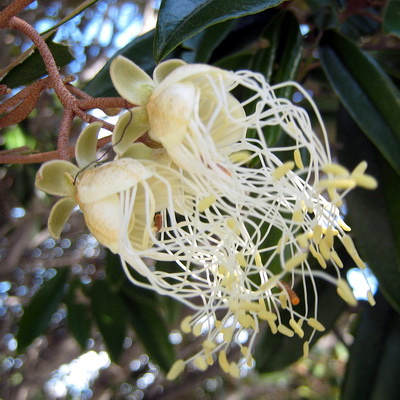
The white flowers look like fireworks because of the long filaments coming from the centre of the flower
Jamaica Caper flowers have very showy, two-inch-long, purple stamens and white anthers and white petals. When the flower first opens usually at night it is white and they turn purple when the morning light hits them.
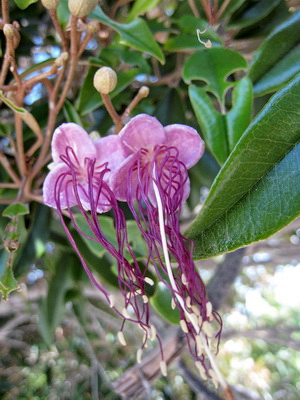
The pinkish purple flowers have numerous long deep purple stamens that burst out of the centre like fireworks
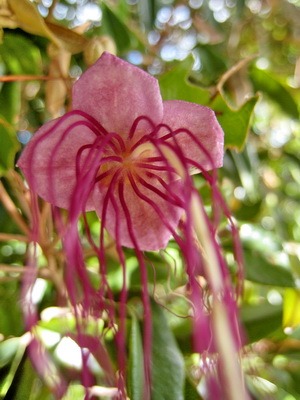
The Caper flower has long two inch stamens that are a purple colour and the flower itself has four petals
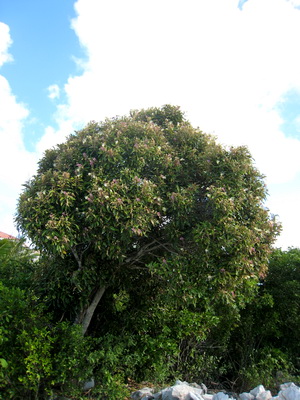
Caper Trees are found growing throughout Provo and keeps all its foliage even when we have drought conditions.
Take a look as you are driving around and see if you can spot these trees. With all the flowers, they shouldn’t be too hard to find.
Marta
I was doing some weeding the other day and came across the most beautiful miniature Passion Flower vine complete with tiny fruits the size of peas. The flowers were a pale yellow and smaller than a dime. I don’t really know what kind of Passiflora it is but it could be a Passiflora suberosa according to some of the books.
My fingers are quite small………my middle finger is 2 1/2 inches long so that gives you an idea of the size. This mini Passion Flower Vine was growing very happily under one of our Palm Trees.
This pretty, small passionflower vine often creeps along the ground throughout the Turks and Caicos Islands. You really have to look closely for it !!
Marta
I was cleaning up the pool area today and discovered my desert rose had a large seed pod that had just burst open. There was a little bit of a wind today so I had a great opportunity to take photos of the seeds before catching the wind and being dispersed.
The Desert Rose has bean-like seed pods. When the seed pod is fully ripe on the plant, it will split open revealing seeds with beautiful “wings” so that seeds can blow away.
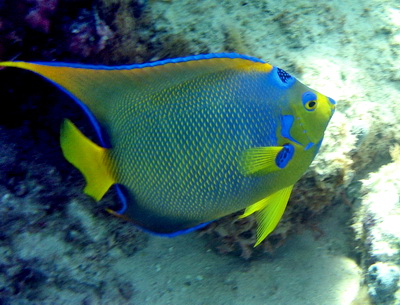
The Queen Angelfish is one of the most beautiful and colourful fish found in the warm waters of the Turks and Caicos Islands
Such amazing colours….electric blue speckled with a bright canary yellow body, yellow tail , fins and a face that has blue highlights around the eyes and mouth. The Queen Angelfish stands out in a crowd because of all that colour but this too works perfectly so that this fish can hide and blend in with the surrounding vibrance of the coral reefs in our area.
The royal title comes from this distinctive marking. It is a blue circle on the top of its head, known as the “crown” that gives this fish its name.
They are quite large for reef-dwellers and can grow up to 18 inches (45 centimeters) in length. The Queen Angel has a rounded head and small beak-like mouth. They have these long upper and lower fins that stream dramatically behind them. Although I love the Queen Angelfish best, The French Angelfish is also among the most beautiful of all the reef fishes.
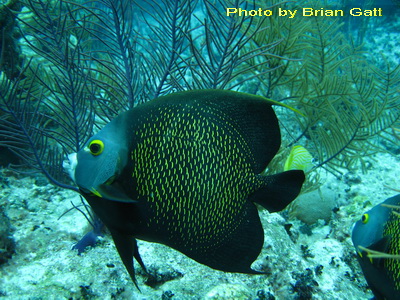
The French Angelfish.....it's scales have bright yellow edges, making a vibrant pattern against its dark blue body.
A big thankyou to our Harbour Club guests Brian Gatt and Connie McEgan for their spectacular photos of the French Angelfish. I don’t dive (only snorkel) so I have to rely on others for underwater photos. The Queen Angel photos were taken by our son Mike on some of his regular visits to Provo.
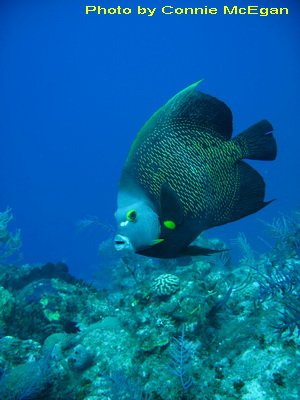
The French Angelfish has a light blue face, gray/white mouth, and yellow highlights on its eyes, gill plates, and fins.
I’m sure you’ll see these exotic fish as you snorkel at Smith’s Reef and the Bight Reef at Coral Gardens. For those that scuba dive, our coral reefs and walls are some of the best in the world. Come to the Turks and Caicos Islands for your next dive vacation and stay with us at Harbour Club Villas. Dive boats leave our Marina every day and if you don’t dive, snorkeling is great here too.
Marta